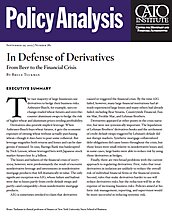The vast majority of large businesses use derivatives to hedge their business risks. Anheuser-Busch, for example, uses exchange-traded wheat futures and over-thecounter aluminum swaps to hedge the risk of higher wheat and aluminum prices eroding profitability.
Derivatives also provide implicit leverage. When Anheuser-Busch buys wheat futures, it gets the economic exposure of owning wheat without actually purchasing wheat—though it does have to post some collateral. But leverage magnifies both returns and losses and can be dangerous if misused. In 1995, Barings Bank was bankrupted by Nick Leeson, whose leveraged bets with Japanese stock market futures lost $1.4 billion.
The losses and failures of the financial crisis of 2007– 2009, however, were predominantly the result of excessive nonderivative leverage and investments in nonderivative mortgage products that fell dramatically in value. The only significant exception was AIG, whose failure and bailout were due to losses partly from credit default swaps and partly—and comparably—from nonderivative mortgage products.
AIG is sometimes invoked to claim that derivatives caused or triggered the financial crisis. By the time AIG failed, however, many large financial institutions had already experienced large losses and many others had already failed, including Bear Stearns, Countrywide Financial, Fannie Mae, Freddie Mac, and Lehman Brothers.
Derivatives appeared at other points in the crisis narrative, but were not systemically important. The liquidation of Lehman Brothers’ derivatives books and the settlement of credit default swaps triggered by Lehman’s default did not disrupt markets. Synthetic mortgage collateralized debt obligations did cause losses throughout the crisis, but those losses were small relative to nonderivative losses and, in some cases, large banks were able to reduce risk by using those derivatives as hedges.
Finally, there are two broad problems with the current approach to regulating derivatives. First, rules that treat derivatives in isolation are unlikely to reduce the overall risk of individual financial firms or the financial system. Second, rules that make derivatives harder to use will reduce derivatives risks; but the reduction will be at the expense of increasing business risks. Policies aimed at holistic risk management, reporting, and supervision would be more successful in reducing systemic risk.
